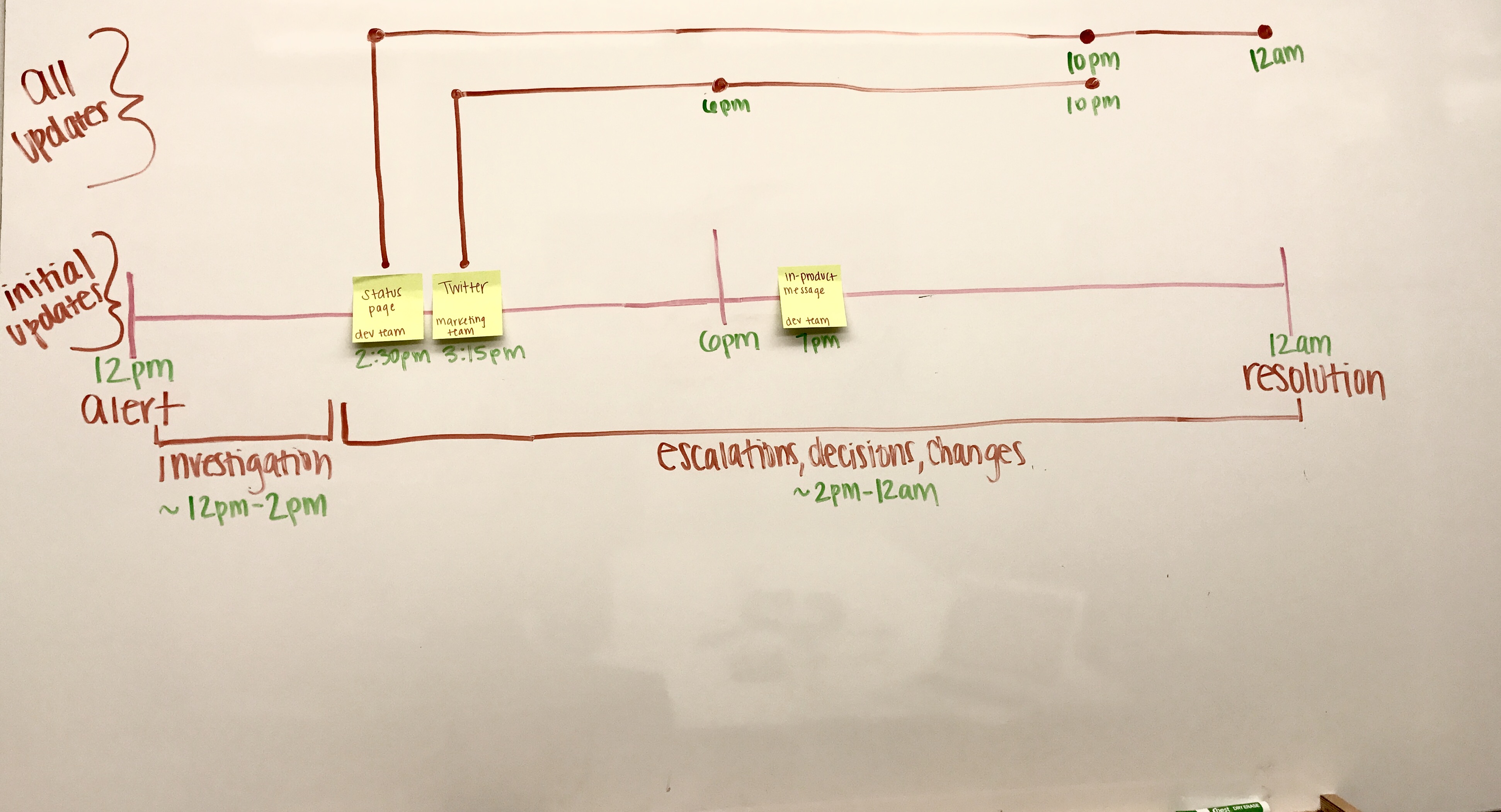
직원
4~10명

준비 시간
45~60분

시간
60분

난이도
중간
플레이 실행
고객 커뮤니케이션이 많이 이루어진 인시던트가 한 번 이상 발생하면 이 플레이를 실행하세요. 다음 인시던트 후에 다시 플레이를 실행하여 어떻게 개선되었는지 확인하세요.
준비물
화이트보드 또는 크라프트지
마커
스티커 메모
준비
최근 인시던트 파악하기(20분)
2시간 이상 지속되었으며 고객에게 불편을 유발했고 고객 커뮤니케이션이 조금이라도 이루어진 최근 발생한 인시던트를 선택하세요.
인시던트에 대한 다음 질문에 답하세요.
- 인시던트가 언제 시작되었습니까? (모니터링/알림 도구를 다시 참조해도 됩니다)
- 인시던트가 언제 끝났습니까?
- 인시던트 조사 단계의 기간은 얼마나 되었습니까?
- 인시던트의 에스컬레이션/의사 결정/변경 단계의 기간은 얼마나 되었습니까?
- 고객이 제품에서 무엇을 보고 문제가 있다는 사실을 알게 되었습니까? (예: 고객이 로그인을 시도할 때 지원 포털로 이동하도록 안내하는 '문제가 발생했습니다' 오류 페이지가 표시되었습니다.) 스크린샷이 있으면 플레이 중에 보여줄 수 있도록 노트북에 저장하거나 인쇄하세요.
- 인시던트 도중/이후에 어떤 커뮤니케이션을 보냈습니까?
- 커뮤니케이션은 어떤 매체를 통해 보냈습니까? (소셜 미디어 채널, 서비스 데스크, 상태 페이지, 이메일, 전서구 등일 수 있습니다. 어떤 의미인지 아실 것입니다.)
- 각 커뮤니케이션을 누가 보냈습니까?
- 각 커뮤니케이션을 언제 보냈습니까?
타임라인 만들기(10분)
세션에 5~10분 정도 일찍 도착하세요(회의실을 예약하세요!). 화이트보드나 크라프트지를 사용하여 인시던트 시작 시간과 인시던트 종료 시간(해결된 시점)을 기록하는 인시던트 타임라인을 그리세요. 원하는 대로 간단하거나 복잡하게 만들 수 있습니다!
최초 알림 ------------------------------------------------------------------- 해결
위에서 답한 질문을 다시 참조한 후 스티커 메모를 사용하여 인시던트 발생 중에 고객 커뮤니케이션에 사용한 시간과 채널을 타임라인에 적습니다.
채널을 두 번 이상 사용한 경우 채널에서 브랜치를 한 개 그리고 사용한 시간을 각각 점으로 표시하세요.

예를 들어...
인시던트 대응 커뮤니케이션 타임라인은 다음과 비슷할 것입니다.

프로 팁
세션이 끝난 후 배운 점을 최대한 많은 동료 및 친구와 공유하세요. 배운 점을 최대한 많은 동료 및 친구에게 이야기하세요. 동료 및 친구는 무엇을 배웠는지 물어보세요. 지속적인 장점을 얻을 수 있습니다.
1단계
회의 준비(10분)
집중하기로 한 인시던트에 대해 설명하면서 세션을 시작하세요. 만든 타임라인을 제시하고 참가자에게 여러분이 그린 것과 인시던트에서 기억나는 것을 바탕으로 타임라인을 살펴보도록 하세요. 포함되지 않은 채널 또는 커뮤니케이션을 모두 적습니다.
이 세션은 참가자가 불만, 혼란, 의견 불일치 등에 대해 솔직하게 이야기할 수 있는 안전한 공간이라는 점을 강조하세요.
2단계
격차에 주의(10분)
커뮤니케이션 타임라인에 간격을 기록하세요.
- 인시던트 시작/최초 알림과 첫 업데이트 사이의 시간: x분/시간
- 첫 번째 업데이트와 두 번째 업데이트 사이의 시간: x분/시간
- 두 번째 업데이트와 세 번째 업데이트 사이의 시간: x분/시간
- 세 번째 업데이트(또는 해결 전의 업데이트)와 해결 업데이트 사이의 시간: x분/시간
마커로 가장 큰 격차에 동그라미를 그려서 해당 부분을 강조하세요.

프로 팁
커뮤니케이션은 일찍(고객에게 영향을 미치는 문제가 감지되는 즉시) 그리고 자주(해결될 때까지 20~30분마다 업데이트 제공) 하는 것이 중요합니다. 그보다 훨씬 길면 이 연습에서 격차로 간주할 수 있습니다.
3단계
커뮤니케이션 평가(15분)
참가자에게 스티커 메모를 사용하여 인시던트 중에 고객 커뮤니케이션과 관련하여 발생한 문제가 되는 격차, 혼란 및 비슷한 문제를 적어달라고 요청하세요. 진행이 막히면 아래의 프롬프트를 사용하세요.
- 고객이 어떤 경로로 오류 페이지에 도달했습니까? 제품/시스템에 오류가 있을 때 고객이 겪는 일반적인 흐름입니까?
- 여러분이 고객이라면 비슷한 문제를 겪었을 때 어떤 기분일 것 같습니까?
- 고객과 일찍 그리고 자주 커뮤니케이션했습니까? (2단계에서 알아본 격차를 통해 답을 알 수 있음) 그렇게 한 이유, 또는 그렇게 하지 않은 이유는 무엇입니까?
- 누가 고객과 커뮤니케이션할 것인지 어떻게 결정했습니까?
- 적합한 고객과 커뮤니케이션했습니까? 그것을 어떻게 알 수 있습니까?
- 커뮤니케이션에 사용하는 매체/채널에 고객이 쉽게 액세스하고 볼 수 있었습니까? 어디에서 찾을 수 있는지 고객이 어떻게 알게 되었습니까?
- 우리가 보낸 커뮤니케이션으로 인해 고객이 지원 팀에 연락할 필요가 줄어들었습니까?
- 인시던트 도중/이후에 우리가 보낸 커뮤니케이션만을 통해 고객이 이 인시던트에 대해 현재 무엇을 알고 있습니까?
4단계
근본 원인 분석(15분)
각 참가자가 타임라인 옆에 "문제" 스티커를 붙이도록 하세요. 참가자가 자신이 작성한 내용을 간략하게 설명하고 문제가 발생했다고 생각하는 이유에 대해 그룹으로 토론하게 합니다. 다른 말로 하자면 인시던트 커뮤니케이션 프로세스에서 문제의 근본 원인이 무엇이었습니까?
예:
- 문제: 인시던트 도중에 4시간 넘게 고객에게 업데이트를 제공하지 않았습니다.
- 근본 원인: 그 4시간 동안 개발 팀에게 업데이트를 받지 못하여 고객에게 어떤 정보를 제공해야 할지 몰랐습니다.

프로 팁
나열한 문제의 근본 원인을 파악하는 데 어려움이 있다면 "5가지 원인" 플레이를 참조하세요.
4단계
계획 세우기(10분)
그룹으로서 방금 수행한 근본 원인 분석을 기반으로 다룰 2~3개의 우선 순위가 높은 문제를 선택합니다. 소유자와 기한을 포함하여 작업 계획을 세우세요.
예를 들면 다음과 같습니다.
| 격차의 근본 원인 | 작성 권장 사항 |
|---|---|
| 아직 어떤 문제인지 몰랐기 때문에 고객에게 의미 있는 정보를 전달할 수 없었습니다. | "불편을 끼쳐드려 정말 죄송합니다. 문제를 긴급하게 조사하고 있습니다." 또는 "아직 문제 x에 대해 조사하는 중입니다. 30분 후에 다시 업데이트해 드리겠습니다."와 같은 막연한 업데이트라도 아무 말도 하지 않는 것보다는 훨씬 낫습니다. |
| 아무도 고객에게 정보를 전달하는 일의 소유권을 가지고 있지 않았습니다 | 다음에 인시던트가 발생했을 때 책임을 명확히 할 수 있도록 인시던트 커뮤니케이션 역할을 명확하게 정의하세요. |
| 무슨 정보를 어떻게 전달해야 할지 몰랐습니다. | 일반적인 인시던트에 대한 템플릿을 작성하거나 인시던트 업데이트에 대한 어조/스타일 가이드를 만들어 인시던트 발생 시 혼란스러운 상황에서 팀이 쉽고 간단하게 참조할 수 있도록 하세요. |
| 팀으로서 일관성 있는 인시던트 커뮤니케이션 계획에 합의하지 않았습니다 | 편리한 템플릿을 사용하여 인시던트 커뮤니케이션 계획을 수립하세요. |
| 인시던트 해결을 누가 담당하는지와 같이 인시던트 커뮤니케이션을 처리하는 팀원에 대한 명령 체계가 없습니다. | 편리한 템플릿을 사용하여 인시던트 커뮤니케이션 역할, 책임 및 에스컬레이션을 결정하세요. |

안티패턴
오로지 플레이를 완료하기 위한 목적으로 작업 항목을 작성하지 마세요. 팀이 추진하는 데 관심이 있는 계획만 문서화하세요.
성공하셨습니까?
팀과 함께 전체 상태 모니터 세션 또는 체크포인트를 실행하여 개선을 이루고 있는지 확인하세요.
후속 조치
모두가 인시던트 커뮤니케이션 프로세스에 정렬되도록 작업 항목을 팀/조직과 공유하세요.
다음 인시던트가 발생한 후에 이 플레이를 다시 실행하여 새로운 커뮤니케이션 프로세스가 실제로 어떻게 진행되었는지 확인하세요. 여기서의 목표는 가장 원활한 커뮤니케이션 계획이 만들어질 때까지 계속 다듬고 개선하는 것입니다.
더 많은 플레이북을 보고 싶습니까?
새로운 상태 모니터 및 플레이를 추가할 때 통보할 이메일을 아래에 입력 후 전송해주세요.
의견이 있으십니까?
Atlassian 커뮤니티 사이트에 질문이나 의견을 남겨주세요.
.jpg?cdnVersion=2595)